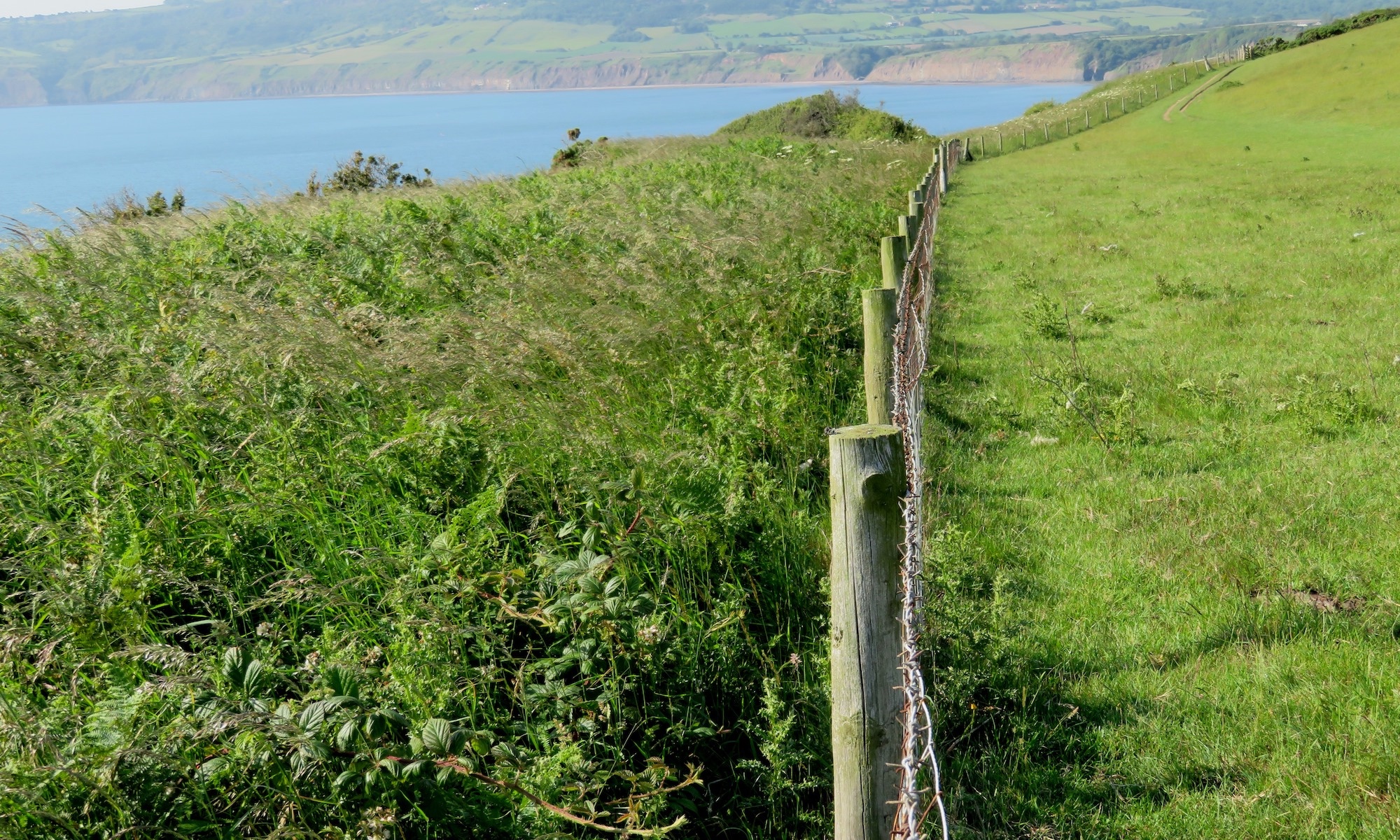by George Valentine
21st July, 2023
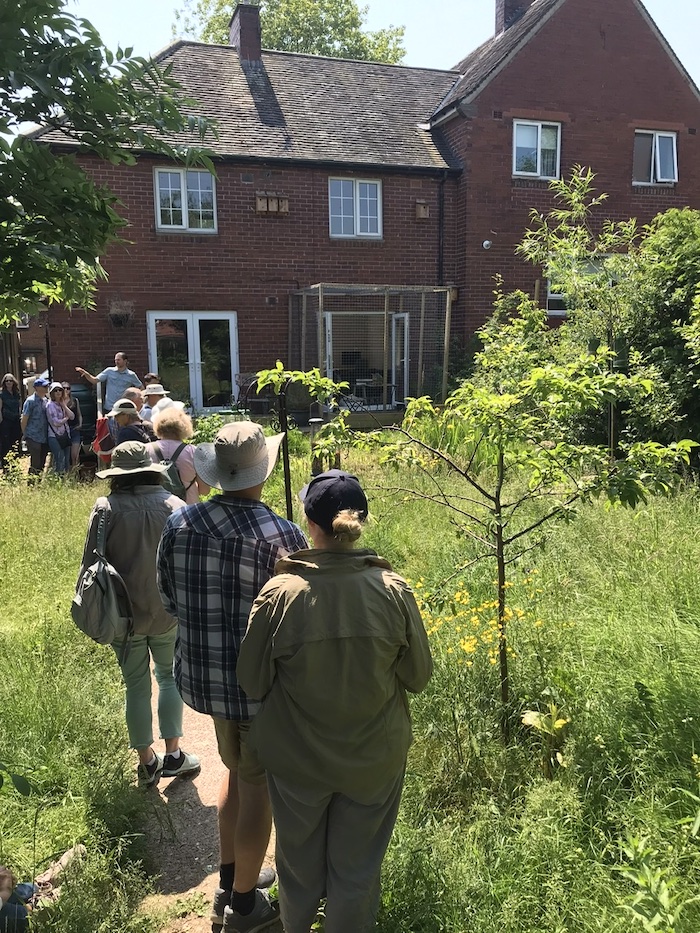
Taking a trip over to the small village of Wharncliffe Side on the outskirts of Sheffield for one of YRN’s summer site visits this year was well worth the journey. I came away with ideas, advice and inspiration that I can put to immediate good use in my own back garden as well as the warm feeling of connecting with others who care deeply about supporting nature recovery and biodiversity.
On the first day of a heatwave, I found myself standing alongside about 20 people gathered on the pavement outside a semi-detached suburban house, being greeted by Dean, the first of three neighbours to open up their gardens to a diverse band of nature lovers. Dean works in ecological restoration on a landscape scale, specialising in woodland and moorland restoration. And he (or rather his ‘tree nursery’ of rescued saplings) had outgrown the tiny back yard of his previous home in Sheffield. Moving to a location outside the city has given him a larger garden in which to nurture his dreams. By creating different habitats, albeit in a small space, Dean’s front garden is in the process of being transformed into a place which is much more welcoming to birds, insects and small mammals. A native hedgerow has been planted along the boundary fences and these shrubs have already reached a size whereby they provide dappled shade and foliage for birds and insects to hide in.
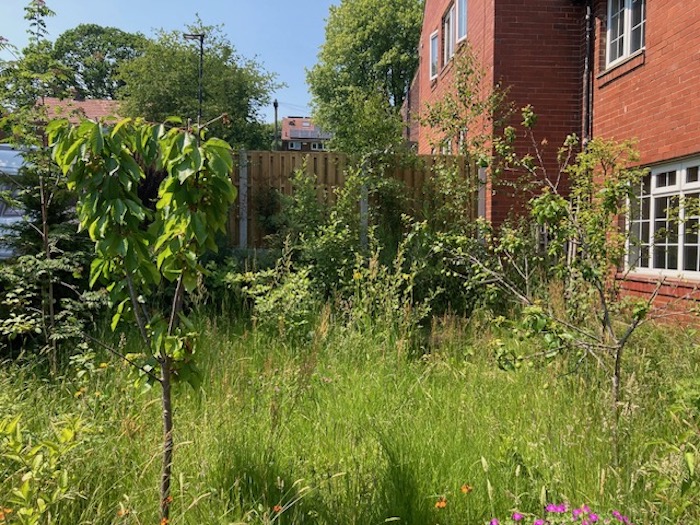
Several young silver birch trees swayed gracefully in the breeze on one side, and a small wildlife pond has been dug and lined – already established with aquatic plants despite being only 15 months old. Coir mesh around the edges of the pond covers the liner and helps plants to establish themselves, and will eventually rot away. We discussed the pros and cons of coir mesh as it also acts like a wick, lowering the water level through capillary action, which may be a problem in the drier, summer months. The ‘lawn’ area is gradually transforming into a meadow with a wide mix of wildflower species to support pollinators and other invertebrates, as well as birds and small mammals. Yellow rattle is doing its semi-parasitic work of suppressing tall grass species to allow more varied but less vigorous meadow species to establish. The problem of over-fertile soil is one of those counter-intuitive aspects that I’m learning about, and by strimming the meadow once a year in autumn or winter (mimicking the action of ancient wild herbivores), removing the arisings (grass cuttings), and not using any fertilisers or pesticides, healthy soil ecology will re-establish.
Dean has also created a wildlife pond in the back garden and introduced aquatic plants such as yellow flag iris, water mint, lesser water spearwort, marsh marigold and water forget-me-not. As red and blue damselflies danced over the surface, we discussed how much intervention is required to help nature rebalance itself… including the issue of ‘weeds’. Dean explained how cleavers, brambles and nettles, although not harmful in themselves and, in fact, very beneficial for wildlife, can be so vigorous in their growth that if you don’t keep them in check then other plants that you are trying to encourage won’t have chance to establish. Rewilding is not about doing nothing!
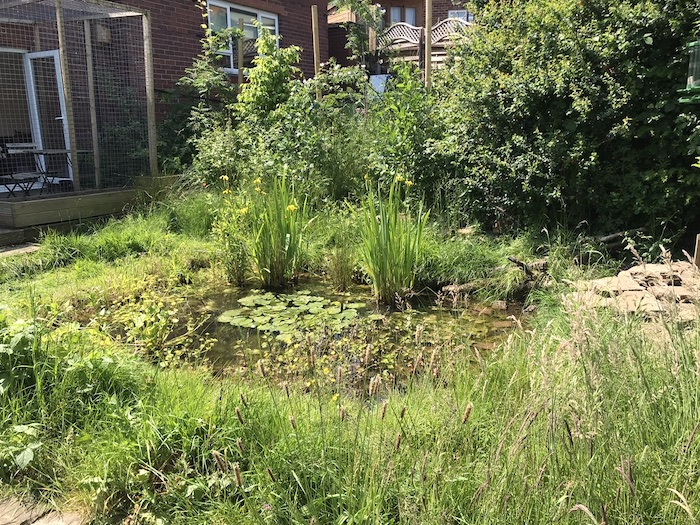
Dean has also built some raised beds near the house and is exploring veg-growing for the first time this year. He has also constructed what looks like a large outdoor ‘bird cage’ on his decking but this is actually for his cats to enjoy being outside but not roam the garden, keeping both cats and wildlife safe. Domestic cats place additional pressure on wildlife, particularly in spring and summer when fledging birds and young mammals are most vulnerable. Providing a ‘catio’ is a wildlife-friendly and responsible way to be a cat owner. Someone in the group also noticed the privet at the bottom of the garden next to the composting area and mentioned how good it is for moths when allowed to flower.
When space is limited, as is often the case with gardens, it’s always a difficult decision about what to retain and what to remove. This is where our long-term vision of ‘what’s possible’ evolves, with no right or wrong answers, and where instead of simply imposing our will, we collaborate with nature.
Our next stop was Andrew’s house on the opposite side of the road. Flanked by mature trees, the front lawn is in the early stages of transforming into a wildflower meadow, in sharp contrast to the neighbouring house with its artificial turf lawn: Here’s hoping that good relationships with our neighbours will help nature-friendly approaches be better understood as they become more mainstream! Andrew explained that vegetation on the lawn had been allowed to colonise naturally for a few years. Birds-foot Trefoil, vetches, knapweed and buttercups were already established in some areas, and last year the lawn was scarified and seeded with yellow rattle, again doing its transformational work. Quite a number of tree saplings had been planted as an understory to the mature trees along the side of the house including holly – yet to reveal its gender. I learned that holly trees are either male or female, with berries only appearing on female plants. Pyracantha was part of the existing garden and although non-native it supports greenfinches and other birds that eat the fruit during winter. Andrew plans to plant more rowan and other berry-bearing trees to help over-wintering birds. There was also hazel which, if allowed to grow freely without trimming it back, will bear fruit and provide nuts.
At the back of the house Andrew has dug a large pond which almost entirely filled the lower terrace. He had to move large amounts of stone – as many of us have found, builders quite often dump unwanted stone and rubble, covering it with a few inches of soil, and what you think is a garden is actually a building site underneath! Thankfully, given the chance, nature will colonise anywhere but depth of soil will limit the outcome. Introducing a pond is widely considered the best thing you can do for wildlife, and we discussed the difficulties that filling it with tap water pose (its high nutrient content tends to create algal blooms). Introducing oxygenators – submerged water plants – will help to remedy this over time, and provide excellent habitat. Harvesting rainwater and channelling it into the pond is also a great way of addressing this, if feasible. Andrew pointed out the upper terrace, currently an informal ‘tree nursery’ which he hopes over time to convert to a ‘heathland’ area with gorse, broom, heathers and bilberries. One of the visitors suggested that keeping an area aside available for potting on and nurturing seedlings is an invaluable part of a rewilder’s living space.
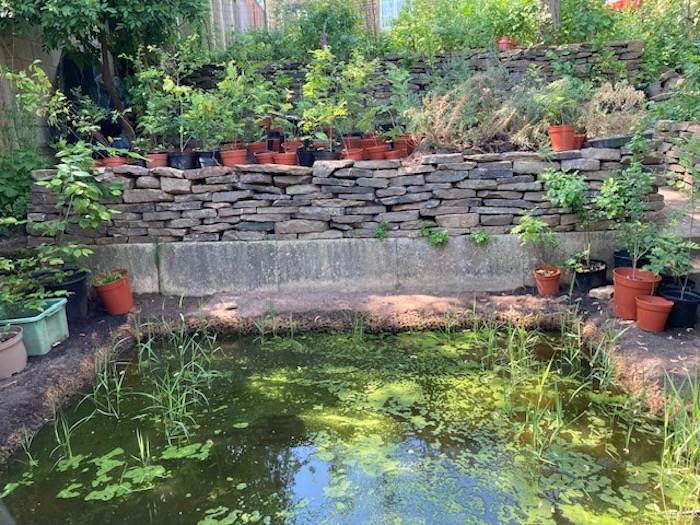
After a very pleasant walk up the hillside, our next stop was a private orchard in a small hamlet called Brightholmlee. Dhira explained that the hamlet she has lived in all her life was originally inhabited in the 1200s and rebuilt in the 1600s1700s. In 2014, Dhira acquired a small parcel of land which was originally an old orchard belonging to Brightholmlee Old Hall that had become neglected and subsumed into a large, grazed field. She described her vision of restoring it into an orchard and, with help from volunteers, managed to raise funds for new fruit trees by offering local residents and others the chance to dedicate them in memory of a loved one. Some of the fruit trees are now fairly well established, others are still in their early stages and require watering during the summer months. With no water supply in the field this has been quite challenging, and it remains a question as to how this will be managed in the long term, especially with climate change.
Dhira has received invaluable help from both Dean and Andrew in caring for the trees, and with helping to create a wildflower meadow between and beneath the fruit trees. Raking, strimming and scarifying the soil in autumn and sowing yellow rattle (from Habitat Aid) and wildflower mix (from Forest of Flowers in York) is helping to reduce the rank grasses and increase the variety of species. It turned out that some of the first fruit trees had been supplied on dwarf rootstock by mistake (their reduced vigour is not ideal for northern areas of Britain). These trees have been moved to the side of the orchard and Yorkshire Heritage varieties on the correct rootstock have been planted in their place. There have been other challenges including the fungal infection ‘pocket plum’ and aphid damage, and severe pruning was needed. The trees are being watered regularly and fed with seaweed nutrients to help them establish and thrive.
There is a clay-lined pond in the orchard but it failed, creating a ‘seasonal’ pond. Fruiting hedgerow shrubs have been planted along the boundary and a small, enclosed area with a dry-stone wall boundary is currently serving as a temporary tree nursery. Dhira pointed out some young oak trees that she had grown from local acorns and some self-seeded oaks which are doing well in a bramble thicket. It was lovely to see this ancient relationship in which young trees are protected from browsing animals by dense patches of thorny scrub that act as a ‘nursery’ for the young trees. As the trees grow in size and cast denser shade, the brambles will die off having done their job and disperse elsewhere. We admired a pear tree, fruiting for the first time this year, having been grafted onto pyrus rootstock from an ancient local pear tree with a family connection. As Dhira told her story it was wonderful to see how particular trees become intertwined in our lives and hold a significance which goes beyond the material. A sense of place and a sense of belonging are nurtured over the years as we invest our time and care in the places we inhabit. These silent guardians become custodians of our memories; their gentle, uncomplaining presence a source of comfort.
Dhira’s home nearby was inherited in 2006 when her mother, a keen flower arranger, passed away. Over subsequent years Dhira designed several different plans for the garden, including a large amount of topiary, but over the last couple of years she has gradually transformed the formal elements of the garden and encouraged its transformation into something ‘wilder’. The back garden has an amazing view over the valley and has some wonderful mature trees reaching for the sky, surrounded by a gently sloping hillside overlooking the wooded valley beyond. Regarding plants, she has applied the principle of 80% native, 20% non-native as a general guide, and has an aim for successional fruit tree blossom to flower continuously for six months of the year. She has almost achieved this aim, and her latest addition is a non-native winter-flowering cherry that she hopes will fill this niche. The front garden has blackthorn, plum, pear, cherry and medlars, and again, the issue of watering in the early stages of tree life was a discussion point.
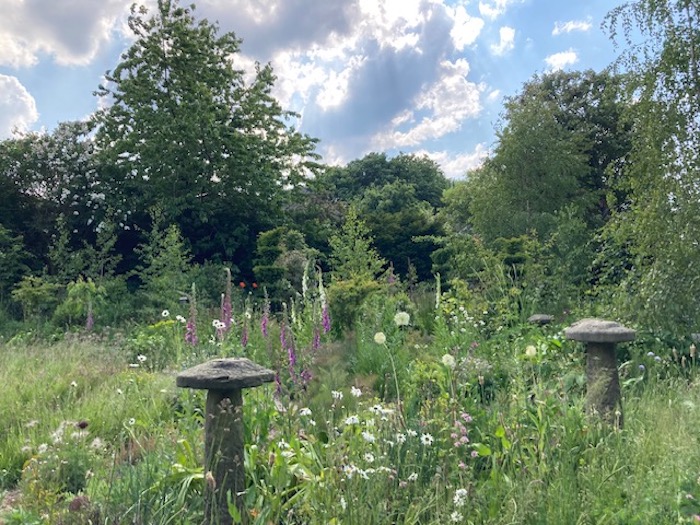
In the back garden, Dhira has planted 10 silver birch trees to create a woodland area. She spent time and energy removing large areas of gravel only to realise retrospectively that it wasn’t essential. It’s great to learn from each other so that we can all benefit from the lessons learned. Small fragments of the remaining topiary speak of the garden’s formal past. Beautiful stone troughs, now filled with sedums and other rockery plants, looked like wonderful organic works of art, the plants moulding themselves perfectly round the worn edges of the stone, decorating it with their fleshy soft pinks and greens. What I thought were several large sculptures of toadstools punctuating the garden I discovered were actually ‘staddle stones’ (used in the past to raise a granary or hayrick off the ground), another integral part of this dwelling’s history.
The ‘meadow’ area of the garden is now 10 years old and filled with lady’s lace and other gorgeous meadow flowers waving in the breeze. Dhira has created a ‘habitat pile’ from a felled non-native tree, piling the branches into a large heap and planting 10 dogroses around it to create thorny scrubby, ideal for wrens and other small birds. A large pond has had to be re-lined as the original clay-lined pond leaked. Additional boggy areas have been created around the edge of the pond by digging trenches 18 inches deep, lining with pond liner, back-filing with soil and filling with water. These have been planted with bog plants such as angelica, ragged robin, purple loosestrife and yellow flag iris. Newts and frogs populate the pond and barley straw concentrate helps to keep the water clear. We gazed up at the barn owl box high up on the side of the house, with its ledge to help the young owls fledge. Dhira is looking for a new home for her ‘natural beehive’ which is a hollowed-out log/tree trunk set high up on legs. Honeybees are effectively livestock and known to compete for resources with native bumblebees, solitary bees and other pollinators. Dhira wants to concentrate her energy on supporting these invertebrates by creating a ‘sand bank’ area that bees can burrow into to create their homes.
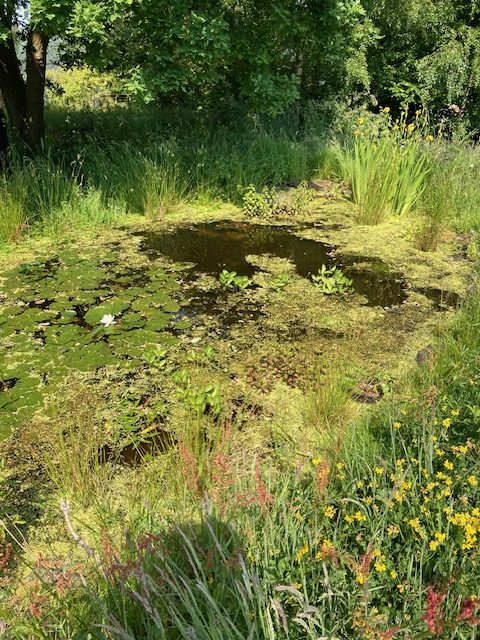
The afternoon ended with refreshments kindly provided by Dhira; a refreshing, cool elderflower cordial and home-made biscuits – most welcome at the end of a hot afternoon. People chatted and made those all-important connections… sharing knowledge, enthusiasm, friendship and a sense of hope and purpose. It is clear that these three neighbours are supporting each other to achieve far more than they would if working alone. Whether it’s knowledge, practical assistance or moral support, a shared dream of a better world is what brings us together.
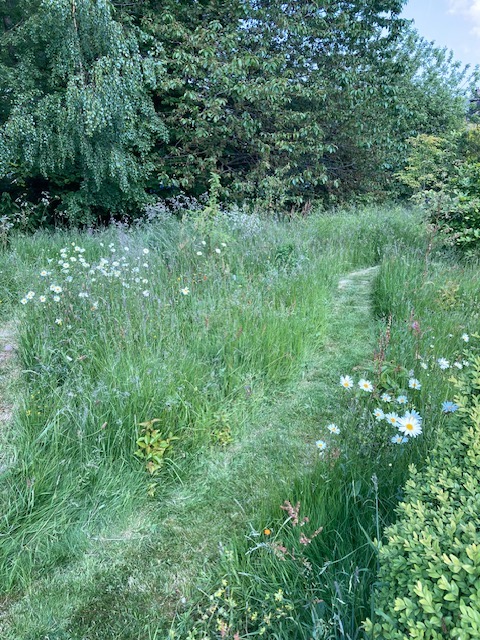
Useful links:
Wilder Ewden and Wharncliffe Facebook group
